

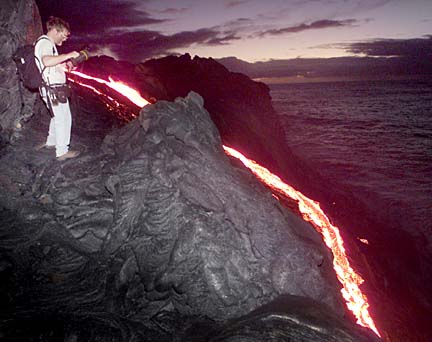
|
Going with the flow On Jan. 3, 1983, Kilauea Volcano erupted. And it hasn't stopped. This Friday marks 20 years of creation and destruction.
Fright and delight | Creation's caldronStar-Bulletin staff
The eruption has changed the shape of the Big Island. It has changed the lives of residents who lost homes and property to lava flows that wiped out entire communities. And it has changed the way scientists think about Kilauea.
DEAN SENSUI / DSENSUI@STARBULLETIN.COM
Kilauea's Puu Oo vent spewed a river of lava in July 1983, six months after the 20-year eruption began.
Today the Star-Bulletin begins a five-part series documenting the longest eruption on Kilauea's east rift in 600 years.
Star-Bulletin reporter Rod Thompson and photographer Ken Ige detail some of the discoveries made by scientists working at the Hawaiian Volcano Observatory including what they believe set the stage for this long-running eruption.
Thompson also recounts the stories of former residents of Royal Gardens, Kalapana and Kapaahu and how Big Island Civil Defense officials balanced life-saving initiatives with cultural sensitivities.
Throughout the week there will be stories about the economic impact the eruption has had on the Big Island, how a Web site makes images of the eruption available around the planet and how a small Catholic church that was saved from destruction sits mostly unused along the side of a road.
A 5-part special report
BACK TO TOP |
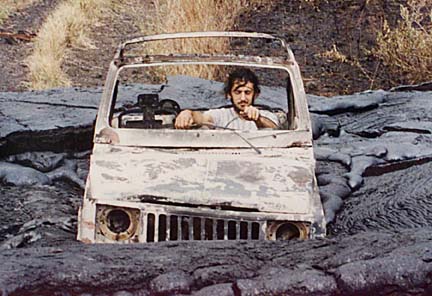
|
The fire below HILO >> An insistent voice coming over a citizen's band radio woke Big Islander Coco Pierson early on the morning of Jan. 3, 1983.
Kilauea's eruption marks
2 decades of fright and delightBy Rod Thompson
rthompson@starbulletin.com"Wake up! Wake up! Get up!" the voice said. "Look out the window."
"I did," Pierson said, "and the sky was all red."
Kilauea volcano was erupting.
Pierson was living in Royal Gardens subdivision, a mostly undeveloped 1,800-acre community on the eastern boundary of Hawaii Volcanoes National Park.
Thanks to the call from park ranger Francis Kuailani, Pierson was one of the first people to see the start of a record-breaking eruption.
In historical times only the 1969-1974 Mauna Ulu eruption has lasted more than a year on Kilauea's east rift. By this Friday the current eruption will have lasted 20 years.
It is the longest east rift eruption in 600 years and shows no signs of stopping.
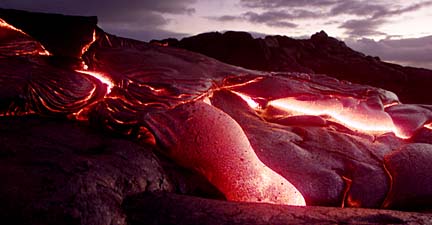
|
In 20 years, Royal Gardens and Kalapana village were decimated. Kalapana Gardens subdivision and Kapaahu homestead were wiped off the map. Lava destroyed 189 buildings valued at $61 million.Twenty-two people died, many from entering restricted areas.
Police and Civil Defense tried from the start to protect lives. On March 2, 1983, lava destroyed its first house in Royal Gardens. Authorities ordered an evacuation. Pierson wasn't happy.
"They would throw everybody out of the subdivision. The first time, it wasn't pleasant, and I don't want to talk about it."
Authorities later relented somewhat. But former resident Timothy "Oly" Kern gave an example of why authorities were cautious. He and a friend were in Royal Gardens looking uphill at a slow-moving aa flow creeping down a subdivision street.
"Suddenly it broke through and just started gushing downhill," he said.
"We just jumped in our cars and went on down," he said. Fortunately the gush petered out.
Former resident Mindy Clark estimates she evacuated 30 times over the years. The main vent, Puu Oo, often erupted in the middle of the night.
"It sounded like a jet taking off," she said.

|
In 1984 a flow bypassed Royal Gardens and hit part of the Hawaiian community at Kapaahu.Civil Defense Director Harry Kim, now mayor, let Samson Kaawaloa watch his house burn.
"He had no choice," Kaawaloa said. "I was mayor, too, down there."
Life before lava was really good, Kaawaloa said. He could hunt pigs right outside his back door, fish in the ocean downhill and grow taro in the fertile soil. Now, like other Hawaiians from the area, he lives miles from Kalapana and waits for the state to fulfill a promise to create a new community on the coast at Kikala-Keokea.
On June 12, 1985, geologist George Ulrich had just taken a temperature reading of fresh lava, 2,079 degrees. Suddenly a lava crust broke, and Ulrich stepped into the lava over his boots but was protected by NOMEX burn-resistant clothing.
Another geologist pulled him out in about five seconds. Ulrich was flown to Straub Clinic & Hospital on Oahu for treatment of first-, second- and third-degree burns. He recovered fully.
In July 1986 the eruption shifted downslope to Kupaianaha lava pond and began producing fluid pahoehoe flows that were carried great distances by lava tubes. Starting the night before Thanksgiving 1986, Kapaahu caught the full force of the change.
"We weren't afraid," said former resident Becky Pau.
From 1955 onward, she and her husband, Louis, had evacuated five times over the years, without damage.
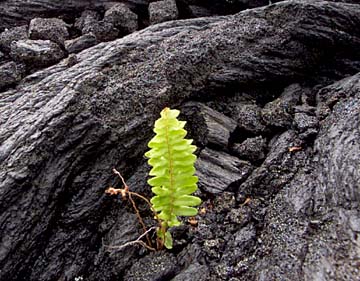
|
Two weeks before the Thanksgiving flow, resident Emma Kauhi suffered a sharp pain in her lower back. She was in Hilo Hospital the night the flow entered Kapaahu.After the lava destroyed her house, the pain disappeared "overnight" and never returned.
Land developer David Watumull felt sympathy for the Kapaahu Hawaiians and sold them 1-acre parcels in his Hawaiian Paradise Park subdivision for $1 each.
Immediately seaward of Kapaahu lay Pacific Paradise Oceanfront Estates subdivision.
Ed Frazer, who lived there, went over to a friend's house in Kapaahu as the lava approached, ate sardines, onions and poi, drank beer, lifted weights, went home and fell asleep. Lava had started to cross the road from Kapaahu to Pacific Paradise.
In the morning, Civil Defense Director Kim sent three trucks to Frazer's house with orders for him to load his belongings and get out. "You're just busy moving your stuff, figuring out what to pack. You cry later," Frazer said.
After destroying 11 homes, the lava stopped, shifted to nearby Kalapana Gardens, destroyed 17 more homes and stopped again.
The lava returned in March 1987, heading toward the large, water-filled crack that Hawaiians called Punaluu, "the diving spring." Others called it Queen's Bath.
"I used to go there every morning and swim," Frazer said. "Everybody would go there on a hot day after school."
Queen's Bath was right outside the national park. Ranger Mardie Lane was there the night lava filled it.
"You could see it boil," she said. Tiny fish and shrimp lived there.
"It was almost like a miso soup because of all the creatures in the water," she said.
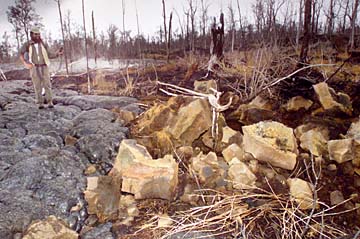
|
The direct road from Royal Gardens to Hilo was cut by lava. A drive to Hilo now meant a 120-mile round trip, using the road up to the national park headquarters, then the Hawaii Belt highway down to Hilo, then back.There was no link between the national park road and Royal Gardens streets.
Diehards became resourceful. People had "inside vehicles" within Royal Gardens and "outside vehicles," to go elsewhere on the island, Pierson said. Between the two, people carried supplies on their backs, such as tanks of propane.
"It was brutal," Pierson said.
The walk across the national park alone was up to a mile, and, depending on where they lived, residents had to walk several more miles within the subdivision.
Lava kept inching across the lowland areas of Royal Gardens. People parked their "inside vehicles" as close to the flows as they dared. One by one they miscalculated, and lava ate their cars and motorcycles.
On June 22, 1989, lava destroyed the park's Wahaula Visitor Center. Wahaula Heiau, a 700-year-old sacrificial temple seaward of the visitor center, survived for another eight years.
The bulk of the destruction began on April 4, 1990. Hour after hour, day after day, lava pushed through Kalapana Gardens subdivision, then Kalapana village.
It destroyed community gathering places such as Walter Yamaguchi's store, the Mauna Kea Congregational Church and Harry K. Brown Park.
Then it filled in Kaimu Bay, continued on and destroyed two houses on the far side of the bay before stopping In October.
In seven months, 103 homes and other structures were destroyed. Several other homes and the Star of the Sea "Painted" Church were moved.
During the events of 1990, Civil Defense Director Kim allowed residents much greater access to their homes than in earlier evacuations. A Kalapana elder had set him straight.
"Looking back (to Royal Gardens evacuations), I had kind of a bureaucratic, callous way of looking at things," Kim said recently.
Community elder Minnie Kaawaloa approached Kim during the Kapaahu lava inundation. She said, "Harry, I just want you to know, when you issue the evacuation order, I'm not going to go."
"But if we order you to evacuate, it's for your own safety," he answered.
"What do you know!" she answered.
"She said it with the gentlest of attitude," Kim said. Kaawaloa gave him an entire cultural history of the area.
"Boy, I'm telling you, that was a wake-up call."
Many people got emotional satisfaction from being allowed to stay with their house until it burned.
For former Royal Gardens resident Clark, it was slow agony. She and her husband, John, had torn down their Royal Gardens house, rebuilt it in Kalapana Gardens and now found it doomed.
"Our house was surrounded by lava for three weeks before it burned," she said.
"It was dying a slow, cancerous type of death." The final fire was a relief, she said.
Clarence "Aku" Hauanio, living in Kalapana village, watched neighboring homes destroyed.
"I was getting really hurt," he said.
Then his own went. He used to surf in Kaimu Bay and catch lobsters.
"Now it's nothing," he said.
But like other Kalapana Hawaiians, he retains one special right, to fish along the national park coast, guaranteed to Hawaiians of the area when the park acquired the 49,340-acre "Kalapana extension" in 1938.
To retain the right, Hawaiians must live in the area. For that reason, a new village was authorized in 1991 on state lands at Kikala-Keokea, on the coast about three miles northeast of Kalapana.
But the 48 families who obtained leases were not permitted to move there until infrastructure was built. Last spring, 11 years later, the Office of Hawaiian Affairs committed $1.35 million for the project to be used with $1.75 million from the Department of Land & Natural Resources.
Mary Finley at the Hawaii County Economic Opportunity Council, which assisted with the project, says the estimate for infrastructure completion is now 2004.
Edleen "Tootsie" Peleiholani, vice president of the Kalapana Community Association, now living in Waimea, is like others who are scattered away from Kalapana.
"We all just want to go home," she said.